Coupling Analysis of “Demand–Satisfaction” for Rural Public Service Facilities Based on the Kano Model with Importance–Performance Analysis: A Case Study of Gaoqing County, Zibo City
Abstract
:1. Introduction
1.1. Research Background
1.2. Literature Review
1.2.1. Research on the Demand Characteristics of Public Service Facilities
1.2.2. Research on Satisfaction with Public Service Facilities
1.2.3. Research on the Configuration Strategies for Public Service Facilities
2. Methods
2.1. Research Object
2.2. Methodology
2.2.1. Research on the Type of Demand for Rural Public Service Facilities
- (1)
- Primary screening of the demand for rural public service facilities
- (2)
- Secondary screening of rural public service facilities based on the Kano model
- a.
- Kano questionnaire survey
- b.
- Kano demands determination and facility screening
- c.
- Importance calculation for the facility types after secondary screening
2.2.2. Research on Satisfaction with the Service Quality of Rural Public Service Facilities
2.2.3. Importance–Performance Analysis (IPA) of the Coupling Relationship Between “Demand and Satisfaction” with Rural Public Service Facilities
3. Results
3.1. Differences in Demand for Different Types of Rural Public Service Facilities
3.2. Degree of Demand for Rural Public Service Facilities
3.3. Satisfaction with the Services Provided by Rural Public Service Facilities
3.4. IPA of the Coupling Relationship Between “Demand and Satisfaction” with Rural Public Service Facilities
3.5. Rural Public Service Facility Configuration Strategies
4. Discussion
5. Conclusions
- (1)
- The analysis using the Kano model found that there are 39 public service facilities that are generally in demand in regard to the lives of rural residents. The most in-demand facilities are primary schools and kindergartens, followed by livestock and poultry, aquatic product markets, and nurseries. The least in-demand facilities are grain management offices, village committees, and comprehensive service stations. A breakdown of the results by facility type shows that most items corresponding to educational institution facilities are the most in-demand facilities, reflecting the fundamental role of education in rural communities. Educational facilities, such as primary schools and kindergartens, are considered indispensable, highlighting the need for continued investment and strategic planning to meet basic educational needs. Most items in regard to healthcare, welfare, and market facilities are classified as high priority needs, indicating that rural residents expect to be able to enjoy high-quality healthcare, welfare services, and market facilities. The importance of these facilities highlights the need for targeted resource allocation to improve the quality of rural residents’ daily lives. Some items in regard to commercial and financial facilities are of secondary importance in terms of the urgency of residents’ needs;
- (2)
- The satisfaction survey found that the overall satisfaction of rural residents with the quality of public service facilities is at a medium-to-high level, and there is still lots of room for improvement. The overall satisfaction with administrative and educational institution facilities is relatively high, indicating that the current efforts in these areas are relatively effective, but continuous improvement is still needed to meet specific challenges, such as demographic changes and resource allocation. The overall satisfaction with commercial and financial facilities and market facilities is relatively low, indicating that there is a significant gap between the current level of supply and residents’ expectations;
- (3)
- The IPA analysis identified four quadrants, providing a clear direction for prioritizing improvements to and maintenance of facilities. Areas for improvement: This includes facilities with high importance and high satisfaction, such as primary schools and kindergartens, which should be maintained and further optimized. Areas in urgent need of improvement: This involves items with high importance but low satisfaction, such as market facilities, which require investment of resources as a priority to improve the provision of such services. Areas for follow-up opportunities: This covers items of low importance and low satisfaction, such as cultural, sports, and technological facilities, which can be considered for future development when resources are sufficient. Continue to maintain areas: This covers projects with low importance but an acceptable level of satisfaction, such as administrative facilities, which require maintenance of the current situation.
Author Contributions
Funding
Data Availability Statement
Acknowledgments
Conflicts of Interest
Abbreviations
| IPA | Importance–Performance Analysis |
Appendix A
| Facility Items After Primary Screening | |
|---|---|
| Administrative Facilities | Administrative Organ |
| Village Committee | |
| Judicial Office | |
| Police Station | |
| Construction and Land Management Agency | |
| Enterprise Rural Management Office | |
| Tax Office | |
| Grain Management Office | |
| Economic Service Station | |
| Educational Institution Facilities | Vocational and Technical School |
| High School | |
| Junior High School | |
| Primary School | |
| Kindergarten | |
| Nursery | |
| Cultural, Sports, and Technological Facilities | Tech Station |
| Small Library (Reading Room) | |
| Cultural Activity Center | |
| Small Gymnasium | |
| Fitness Area | |
| Technical Training Station | |
| Healthcare Facilities | Hospital |
| Community Health Center | |
| Family Planning Service Station | |
| Epidemic Prevention Station | |
| Welfare Facilities | Nursing Home |
| Children’s Welfare Institute | |
| Senior Care Service Station | |
| Disability Service Station | |
| Commercial Financial Facilities | Savings and Loan Association |
| Insurance Institutions, Agricultural Cooperatives | |
| Post Office | |
| Supermarket | |
| Drugstore | |
| Bookshop | |
| Handicrafts and Souvenirs Shop | |
| Grain and Oil Shop | |
| Public Bathroom | |
| Hostel | |
| Comprehensive Service Station | |
| Labor Service Station | |
| Production Materials Sales Department | |
| Motorcycle and Bicycle Sales Department | |
| Home Appliance and Agricultural Machinery Repair Shop | |
| Motor Vehicle Repair Shop | |
| Funeral Service Shop | |
| Market Facilities | Vegetables, Fruits, Grains, and Oils, Non-staple Food Markets |
| Livestock, Poultry, and Aquatic Products Market | |
| Small Commodities Wholesale Market | |
| Fuel, Building Materials, and Production Materials Market | |
| Local Specialty, Handicrafts, and Tourist Goods Market | |
Appendix B
| Like | Expected | Indifferent | Tolerable | Intolerable | |
|---|---|---|---|---|---|
| How would you feel if such facilities were available in the surrounding area? | |||||
| How would you feel if such facilities were not available in the surrounding area? |
Appendix C
| Facility | How Would You Feel If Such Facilities Were Not Available in the Surrounding Area? | |||||
|---|---|---|---|---|---|---|
| Intolerable | Tolerable | Indifferent | Expected | Like | ||
| How would you feel if such facilities were available in the surrounding area? | Intolerable | Q | R | R | R | R |
| Tolerable | M | I | I | I | R | |
| Indifferent | M | I | I | I | R | |
| Expected | M | I | I | I | R | |
| Like | O | A | A | A | Q | |
Appendix D
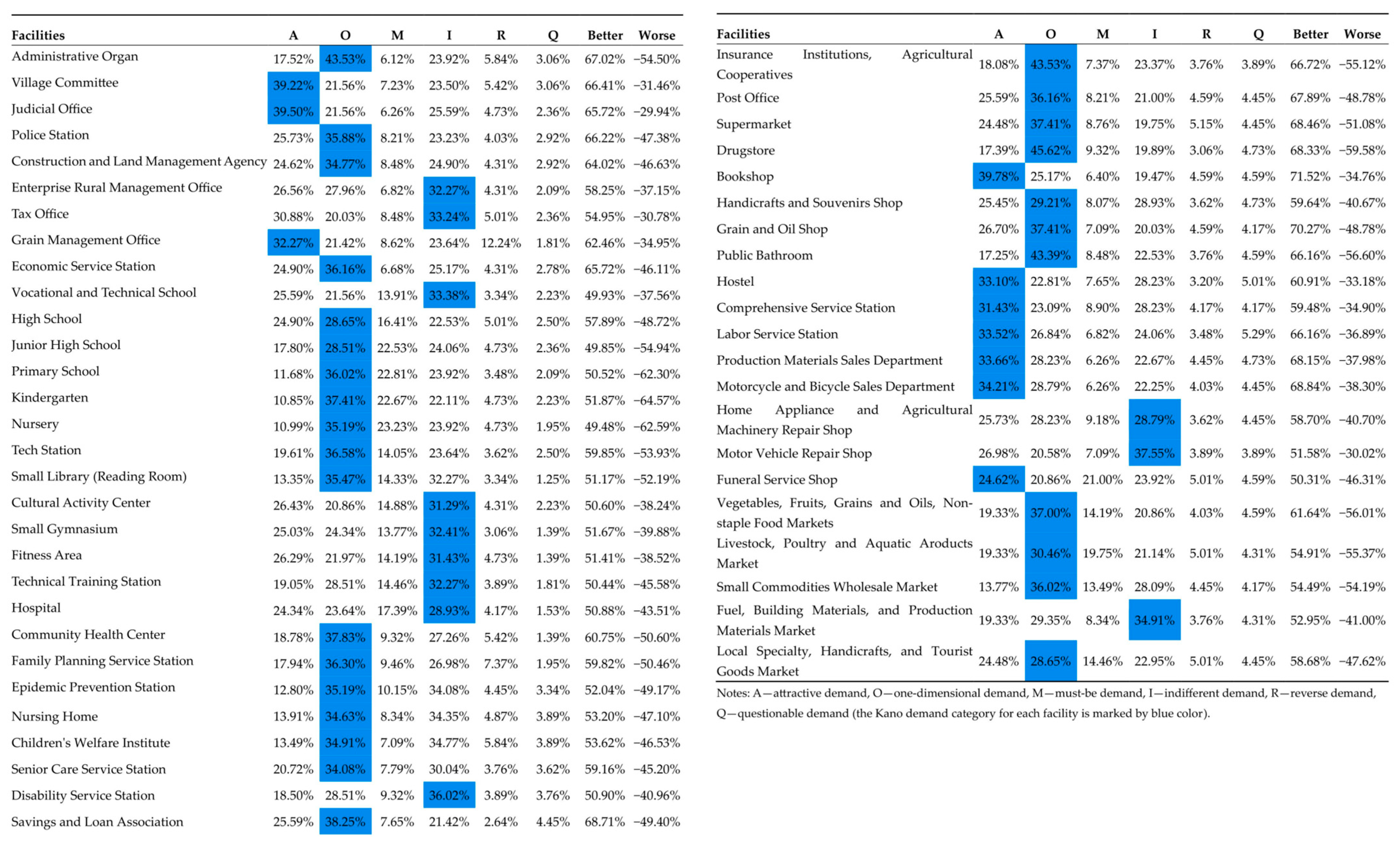
Appendix E
| Facility Items After Secondary Screening | |
|---|---|
| Administrative Facilities | 1. Administrative Organ |
| 2. Village Committee | |
| 3. Judicial Office | |
| 4. Police Station | |
| 5. Construction and Land Management Agency | |
| 6. Grain Management Office | |
| 7. Economic Service Station | |
| Educational Institution Facilities | 8. High School |
| 9. Junior High School | |
| 10. Primary School | |
| 11. Kindergarten | |
| 12. Nursery | |
| Cultural, Sports, and Technological Facilities | 13. Tech Station |
| 14. Small Library (Reading Room) | |
| Healthcare Facilities | 15. Community Health Center |
| 16. Family Planning Service Station | |
| 17. Epidemic Prevention Station | |
| Welfare Facilities | 18. Nursing Home |
| 19. Children’s Welfare Institute | |
| 20. Disability Service Station | |
| Commercial Financial Facilities | 21. Savings and Loan Association |
| 22. Insurance Institutions, Agricultural Cooperatives | |
| 23. Post Office | |
| 24. Supermarket | |
| 25. Drugstore | |
| 26. Bookshop | |
| 27. Handicrafts and Souvenirs Shop | |
| 28. Grain and Oil Shop | |
| 29. Public Bathroom | |
| 30. Hostel | |
| 31. Comprehensive Service Station | |
| 32. Labor Service Station | |
| 33. Production Materials Sales Department | |
| 34. Motorcycle and Bicycle Sales Department | |
| 35. Funeral Service Shop | |
| Market Facilities | 36. Vegetables, Fruits, Grains and Oils, Non-staple Food Markets |
| 37. Livestock, Poultry and Aquatic Products Market | |
| 38. Small Commodities Wholesale Market | |
| 39. Local Specialty, Handicrafts, and Tourist Goods Market | |
Appendix F
| Excellent | Good | Average | Below Average | Very Poor | Not Sure | |
|---|---|---|---|---|---|---|
| Service Quality |
References
- Hao, Y.G.; Zhang, Q.; Wang, Y.B.; Luo, W.C.; Zhang, X.D.; Ma, L.; Chen, D.L. Thematic Discussion: Current Situation, Problems and Countermeasures of Urban and Rural Public Service Facilities Construction in China. Governance 2024, 3, 59–67. (In Chinese) [Google Scholar]
- Zhou, D.L.; Huang, H.M. Study on the Spatial Distribution Characteristics and Influencing Factors of Famous Historical and Cultural Towns and Villages in Fujian Province. Urban Dev. Stud. 2019, 26, 1–5+18. (In Chinese) [Google Scholar]
- He, J.; Zhou, D.; Dai, L.H. Study on Evaluation System of Urban Elderly Living Related Facilities Based on Demand Theories. Archit. J. 2020, S2, 37–44. (In Chinese) [Google Scholar]
- Wan, C.W.; Yang, G.Q. Declining Villages in Mountainous Areas: Demand Willingness Characteristics, Problems, and Trends of Public Service Facilities and Planning Responses. City Plan. Rev. 2020, 44, 77–86+102. (In Chinese) [Google Scholar]
- Zeng, P.; Wang, S.; Zhu, L.H. A Study on the Optimization of Rural Community Living Circles Guided by Shrink Smart Theory: A Case Study of Suning County, Hebei Province. Planners 2021, 37, 34–42. (In Chinese) [Google Scholar]
- Wei, W.; Ren, X.W.; Guo, S.Y. Evaluation of Public Service Facilities in 19 Large Cities in China from the Perspective of Supply and Demand. Land 2022, 11, 149. [Google Scholar] [CrossRef]
- Gao, M.M.; Wang, Z.; Qiu, Z.; Wang, S.C.; Hua, Y. Review and Prospect of Rural Public Service Facilities Configuration from the Perspective of Dynamic Development. J. Hum. Settl. West China 2023, 38, 129–135. (In Chinese) [Google Scholar]
- Li, J.; Gao, X.X.; Li, Y.; Zhang, X.T. Research and Recommended Solutions on Construction Needs of Rural Infrastructure and Public Service Facilities. J. Agric. Resour. Environ. 2023, 40, 1169–1179. (In Chinese) [Google Scholar]
- Wang, M.; Zhang, M.; Qi, Y.; Zhang, D.; Wang, C.; Yao, W.; Zhou, D. Developing a Holistic Approach for Constructing Rural Living Circles in the Loess Plateau—Taking Yongning Village as an Example. Buildings 2024, 14, 514. [Google Scholar] [CrossRef]
- Qiu, Z.; Wang, Y.; Wang, J.; Wang, Z.; Zhou, Y. Needs Hierarchy for Public Service Facilities and Guidance-Control Programming in Small Chinese Towns Influenced by Complex Urbanization of Residents: The Evidence from Zhejiang. Land 2023, 12, 1205. [Google Scholar] [CrossRef]
- Metwally, E.; Samir, E. Assessing Citizen Satisfaction Indicators for Urban Public Services to Enhance Quality of Life in Sharm el-Sheikh. Ain Shams Eng. J. 2024, 15, 102841. [Google Scholar] [CrossRef]
- Hong, M.Y.; Wei, W.; Yin, L.; Xia, J. Exploring the Mechanism of the Impact of Basic Public Service Facilities on Residents’ Satisfaction: Based on the “Homo-Urbanicus” Theory. Hum. Geogr. 2023, 38, 107–117. (In Chinese) [Google Scholar]
- Shen, Y.; Zhang, X.; Zhu, H.; Yin, Z.; Drianda, R.P. Living in a Chinese Industrial New Town: A Case Study of Chenglingji New Port Area. Land 2023, 12, 790. [Google Scholar] [CrossRef]
- Li, J.; Fan, J.; Gao, J.; Zhou, R.; Wang, K.; Zhou, K. Effects of the Spatial Patterns of Urban Parks on Public Satisfaction: Evidence from Shanghai, China. Landsc. Ecol. 2023, 38, 1265–1277. [Google Scholar] [CrossRef]
- Huai, S.Y.; Lin, S.; Zhang, T.C.; Van de Voorde, T. Are Social Media Data and Survey Data Consistent in Measuring Park Visitation, Park Satisfaction, and Their Influencing Factors? A Case Study in Shanghai. Urban For. Urban Green. 2023, 81, 1280–1290. [Google Scholar] [CrossRef]
- Shan, Z.R.; An, Y.H.; Yuan, M.; Huang, Y.P. Study on Spatial and Temporal Distribution Characteristics and Influencing Factors of Urban Residents’ Sentiment Based on Weibo Data: A Case Study of the Main Urban Area of Wuhan. Urban Dev. Stud. 2022, 29, 69–76+2. (In Chinese) [Google Scholar]
- Abdelghany, K.; Abdelghany, A.; Mahmassani, H.; Kaysi, I. Equitable Access to Services in Large-Scale Pedestrian Facilities. Transp. Res. Rec. 2018, 2672, 79–89. [Google Scholar] [CrossRef]
- Su, J.L.; Sook, H.S.; Uk, J.S. Analysis of Locational Pattern and Spatial Service Pattern of Public Service Facilities in Seoul: Focused on Public Sport Facilities. SH Urban Res. Insight 2012, 2, 15–27. [Google Scholar] [CrossRef]
- Chen, C. Discussion on the Optimization Method of Public Service Facility Layout from the Perspective of Spatial Equity: A Study Based on the Central City of Shanghai. Land 2023, 12, 1780. [Google Scholar] [CrossRef]
- Caselli, B.; Carra, M.; Rossetti, S.; Zazzi, M. Exploring the 15-min Neighbourhoods: An Evaluation Based on the Walkability Performance to Public Facilities. Transp. Res. Procedia 2022, 60, 346–353. [Google Scholar] [CrossRef]
- Setyono, A.D.; Cahyono, D.D.; Helmy, M. Measuring Service Capacity of Public Facilities Based on Supply Aspect (Case Study: Elementary School in Malang City). Procedia Soc. Behav. Sci. 2016, 227, 45–51. [Google Scholar] [CrossRef]
- Cho, J.Y.; Park, S.K. Key Factors for Sustainable Operation of Smart Rural Communities in Aging Societies: Voices of Korean Community Leaders. Technol. Soc. 2023, 74, 102306. [Google Scholar] [CrossRef]
- Yang, C.; Xin, L.; Ouyang, H.; Liang, L.; Zhu, M. Research on Optimization Strategy of Public Facilities in Community Life Circle Based on Subjective and Objective Evaluation: A Case Study of Nanning Central City. Shanghai Urban Plan. Rev. 2024, 1, 9–16. (In Chinese) [Google Scholar]
- Hu, P.; Zhang, Y.; Cheng, J.L. Research on Spatial Resilient Governance Strategy of Community Public Service Facilities: The Case of Nanjing City. Planners 2023, 39, 44–50. (In Chinese) [Google Scholar]
- Xiang, S.Q.; Xu, J.H.; Yang, L. Life-cycle Public Service Facilities Provision System Optimization. Planners 2022, 38, 71–78. (In Chinese) [Google Scholar]
- Li, A.; Zhang, J. Equal Urban-Rural Public Service Facility Development. Planners 2011, 27, 7. (In Chinese) [Google Scholar]
- Luo, Z.; Wei, J.; Zhang, J. Study on the Characters of Equalization Development of Basic Public Service Facilities in Urban and Rural Areas—Changzhou as the Case. Urban Stud. 2010, 17, 36–42. (In Chinese) [Google Scholar]
- Zhang, W. The Core Framework of the Livable City Construction. Geogr. Res. 2016, 35, 205–213. (In Chinese) [Google Scholar]
- Cui, X.J.; Ma, L.B.; Tao, T.M.; Zhang, W. Do the Supply of and Demand for Rural Public Service Facilities Match? Assessment Based on the Perspective of Rural Residents. Sustain. Cities Soc. 2022, 82, 103905. [Google Scholar] [CrossRef]
- CECS 354: 2013; Standard for Planning of Rural Area Public Facilities. China Planning Press: Beijing, China, 2013. (In Chinese)
- Kano, N.; Seraku, N.; Takahashi, F.; Tsuji, S.-I. Attractive Quality and Must-Be Quality. J. Jpn. Soc. Qual. Control 1984, 14, 147–156. [Google Scholar]
- National Health Commission. Issuing the Measures for Ethical Review of Life Science and Medical Research Involving Human Being. Available online: https://www.pkulaw.com/en_law/d94e9e56ed4fc8fcbdfb.html?keyword=%E6%B6%89%E5%8F%8A%E4%BA%BA%E7%9A%84%E7%94%9F%E5%91%BD%E7%A7%91%E5%AD%A6%E5%92%8C%E5%8C%BB%E5%AD%A6%E7%A0%94%E7%A9%B6%E4%BC%A6%E7%90%86%E5%AE%A1%E6%9F%A5%E5%8A%9E%E6%B3%95 (accessed on 24 March 2025).
- Hu, R.; Tao, X.; Gong, J.; Wang, F. Quality Function Deployment Approach to Urban Ecological Public Art Design Centred on Resident Needs. Sci. Rep. 2024, 14, 22814. [Google Scholar] [CrossRef] [PubMed]
- Ying, P.; Hazwani, N.H.N.; Ching, H.G. Public Perception of Cultural Ecosystem Services in Historic Districts Based on Biterm Topic Model. Sci. Rep. 2024, 14, 11717. [Google Scholar] [CrossRef]
- de Vasconcelos, C.R.; de Carvalho, R.S.M.C.; de Melo, F.J.C.; de Medeiros, D.D. Improving Quality in Public Health Service: An Integrated Approach to the Kano Model and the Balanced Scorecard. J. Nonprofit Public Sect. Mark. 2023, 35, 215–241. [Google Scholar] [CrossRef]
- Tuan, V.A.; Van Truong, N.; Tetsuo, S.; An, N.N. Public Transport Service Quality: Policy Prioritization Strategy in the Importance-Performance Analysis and the Three-Factor Theory Frameworks. Transp. Res. Part A 2022, 166, 118–134. [Google Scholar] [CrossRef]
- Lacerda, A.B.; Souza, A.S.d.S.; Da Silva, G.K.L.; De Azevedo, E.H.M.; De Melo, F.J.C. Basic Health Units Services Quality Assessment Through Kano and SERVQUAL Models. Benchmarking Int. J. 2022, 29, 2858–2880. [Google Scholar] [CrossRef]
- Xu, B.; Shi, Q.X.; Zhang, Y.P. Evaluation of the Health Promotion Capabilities of Greenway Trails: A Case Study in Hangzhou, China. Land 2022, 11, 547. [Google Scholar] [CrossRef]
- Sharareh, K.; Jahan, T.N.; Halil, N. Service Quality Assessment and Enhancement Using Kano Model. PLoS ONE 2022, 17, e0264423. [Google Scholar] [CrossRef]
- Jomnonkwao, S.; Champahom, T.; Ratanavaraha, V. Methodologies for Determining the Service Quality of the Inter-city Rail Service Based on Users’ Perceptions and Expectations in Thailand. Sustainability 2020, 12, 4259. [Google Scholar] [CrossRef]
- Simpson, G.D.; Parker, J. Data for an Importance-Performance Analysis (IPA) of a Public Green Infrastructure and Urban Nature Space in Perth, Western Australia. Data 2018, 3, 69. [Google Scholar] [CrossRef]
- Pan, M.; Huang, Y.; Qin, Y.; Li, X.; Lang, W. Problems and Strategies of Allocating Public Service Resources in Rural Areas in the Context of County Urbanization. Int. J. Environ. Res. Public Health 2022, 19, 14596. [Google Scholar] [CrossRef]
- Li, X.L. Focusing on Improving the Supply Level of Rural Basic Public Services. Agric. Econ. 2022, 6, 30–32. (In Chinese) [Google Scholar]
- Kano, N. Life Cycle and Creation of Attractive Quality. In Proceedings of the 4th QMOD Conference, Linköping, Sweden, 12–14 September 2001. [Google Scholar]
- Wen, J. The Supply of Rural Public Cultural Services Relying on Data Mining Technology under the Rural Revitalization Strategy. Wirel. Commun. Mob. Comput. 2022, 2022, 1–13. [Google Scholar] [CrossRef]
- Shayo, E.H.; Senkoro, K.P.; Momburi, R.; Olsen, Ø.E.; Byskov, J.; Makundi, E.A.; Kamuzora, P.; Mboera, L.E.G. Access and Utilisation of Healthcare Services in Rural Tanzania: A Comparison of Public and Non-public Facilities Using Quality, Equity, and Trust Dimensions. Glob. Public Health 2016, 11, 407–422. [Google Scholar] [CrossRef] [PubMed]
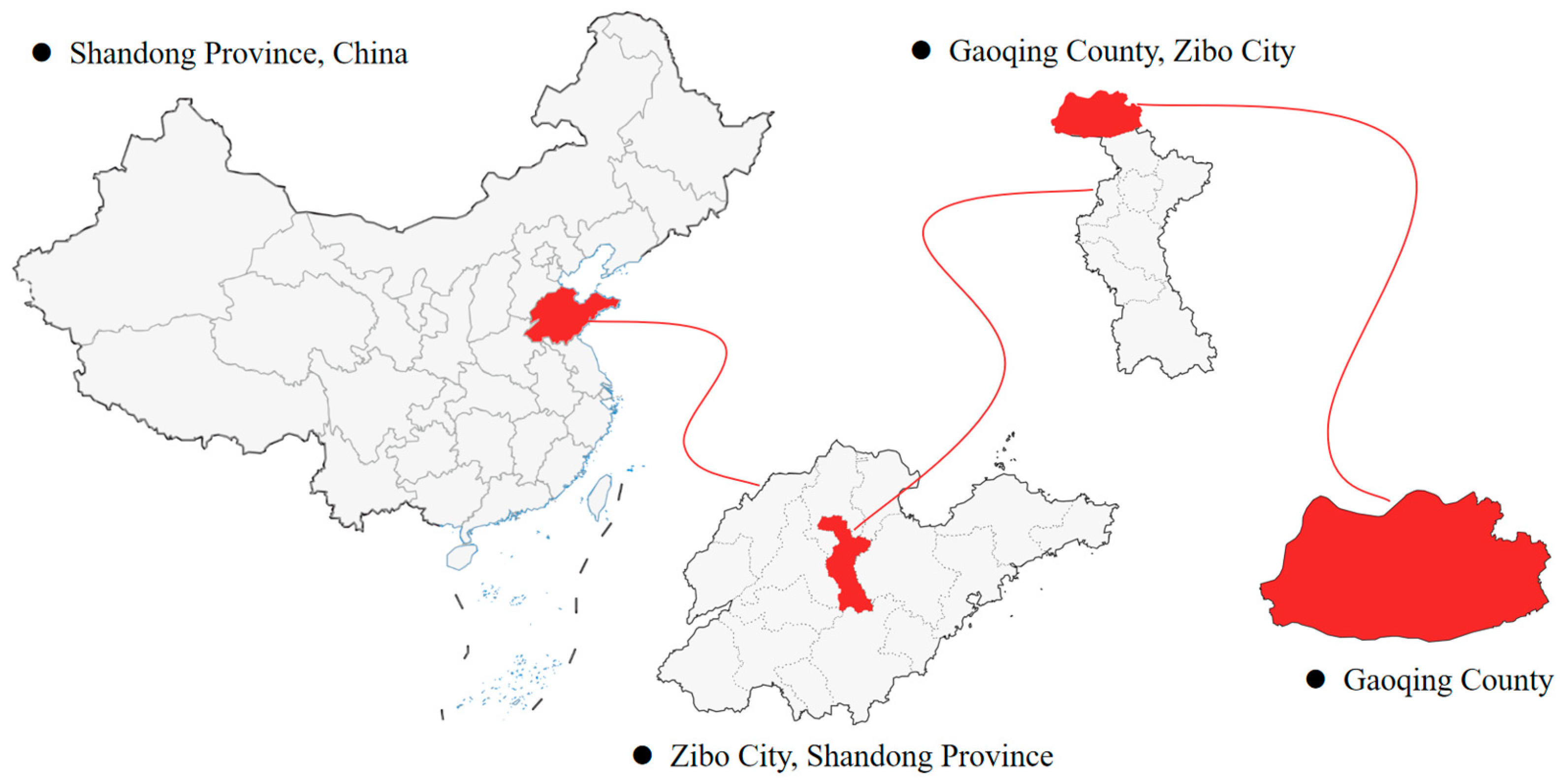
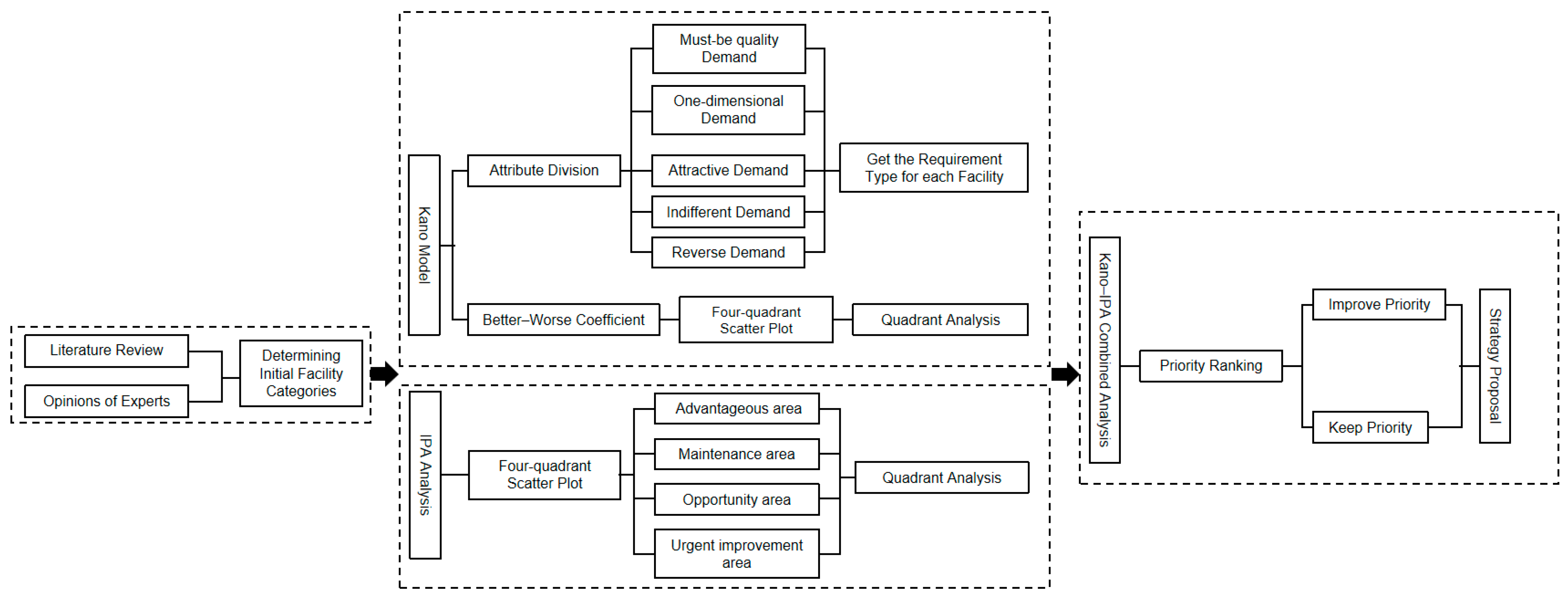


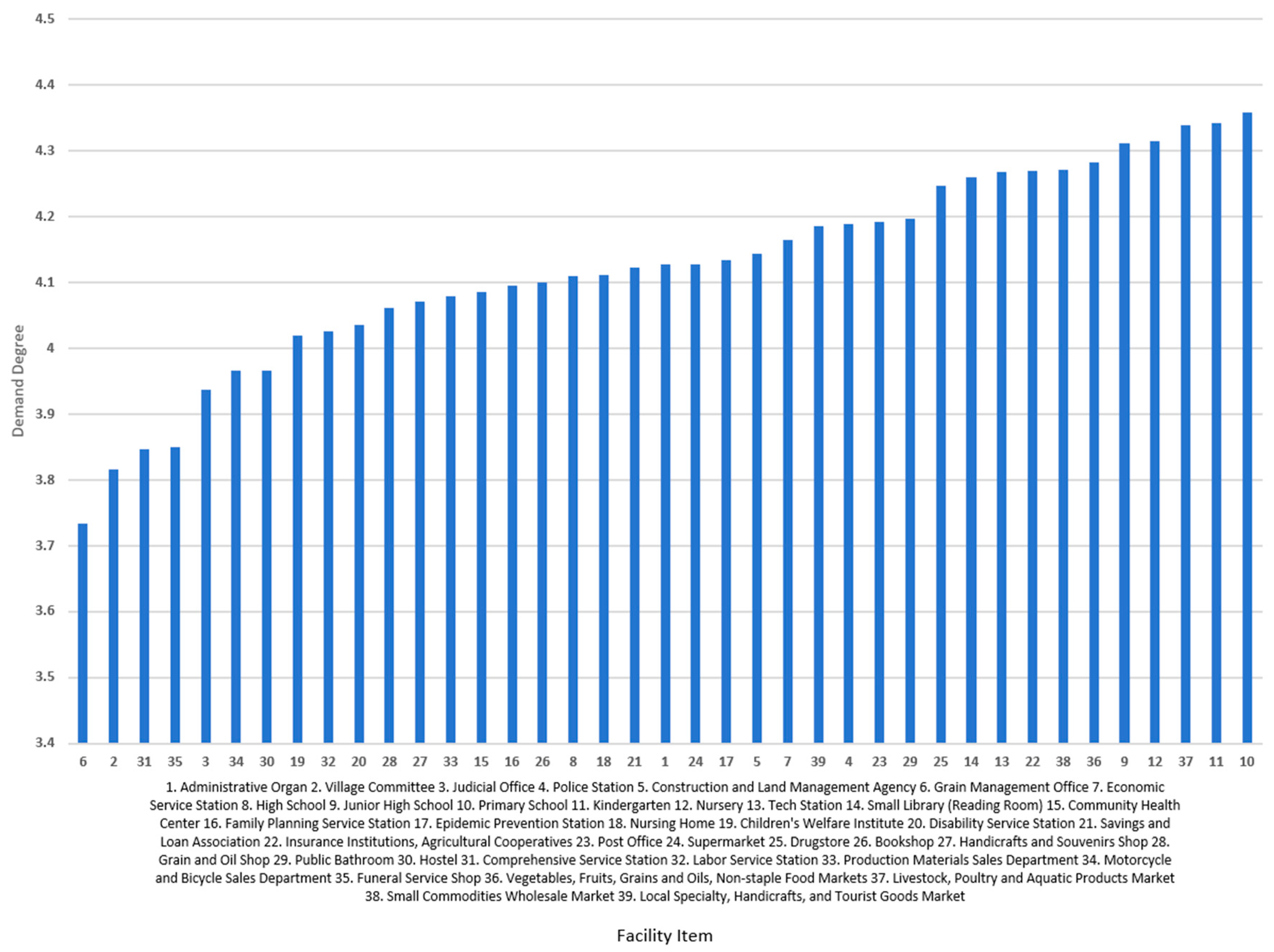

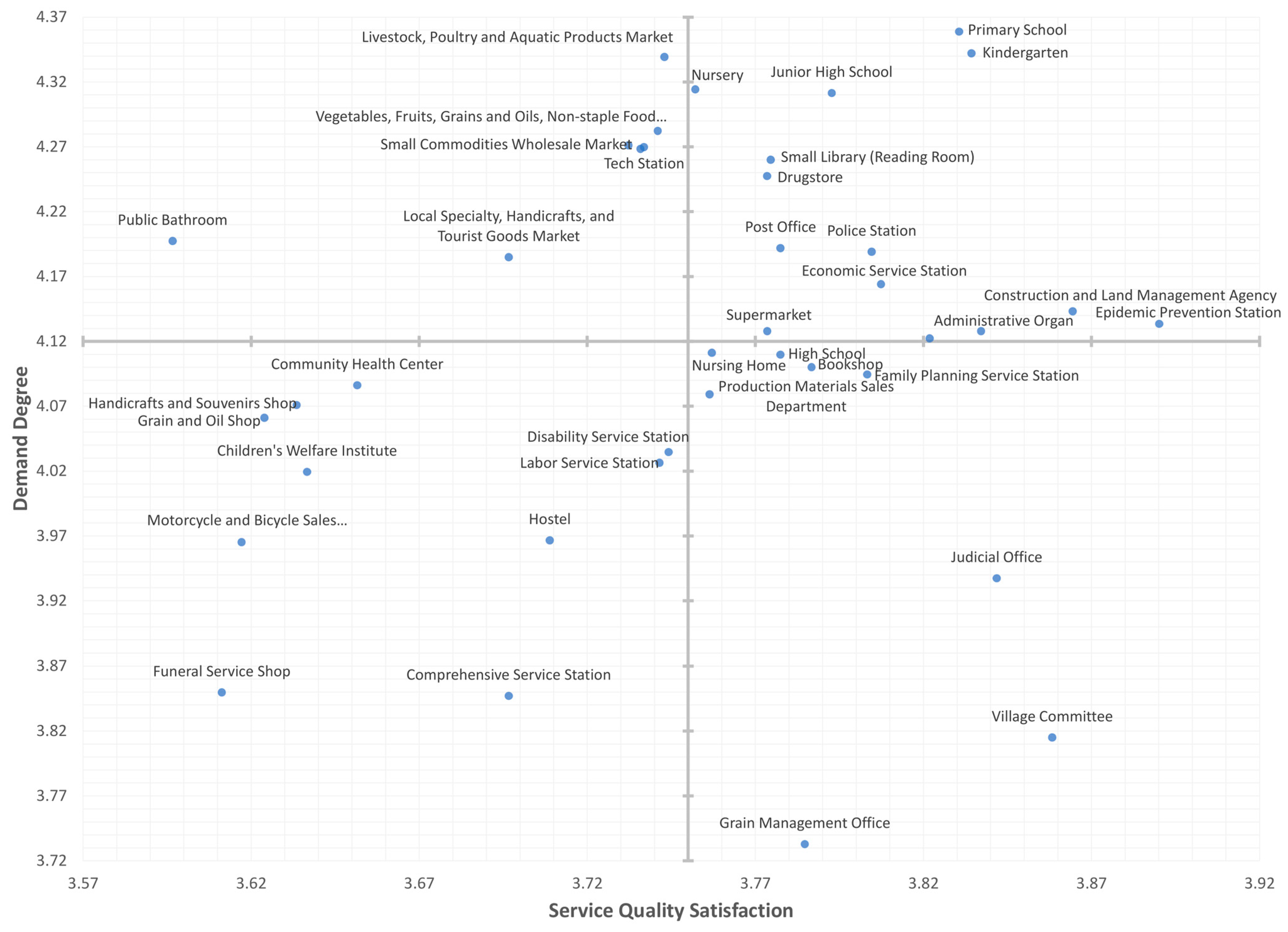
| Positive and Negative Question Options | Do Not Provide the Facility | |||||
|---|---|---|---|---|---|---|
| Like | Naturally Not Provided | Indifferent | Can Tolerate | Highly Needed, Therefore Cannot Tolerate | ||
| Provide the Facility | Like | 3 | 3 | 4 | 5 | 5 |
| Naturally Provide | 2 | 3 | 4 | 4 | 5 | |
| Indifferent | 2 | 2 | 3 | 4 | 4 | |
| Do Not Like But Can Tolerate | 1 | 2 | 2 | 3 | 3 | |
| Cannot Tolerate | 1 | 1 | 2 | 2 | 3 | |
| Kano Attributes | IPA Quadrant | Facilities | Raise Priority | Maintain Priority |
|---|---|---|---|---|
| M | I | 9. Junior High School, 10. Primary School,11. Kindergarten, 14. Small Library (Reading Room), 17. Epidemic Prevention Station | 1st | |
| II | 12. Nursery, 37. Livestock, Poultry, and Aquatic Products Market, 38. Small Commodities Wholesale Market, 39. Local Specialty, Handicrafts, and Tourist Goods Market | 1st | ||
| III | 19. Children’s Welfare Institute, 35. Funeral Service Shop | 2nd | ||
| IV | 8. High School, 18. Nursing Home | 2nd | ||
| O | I | 1. Administrative Organ, 4. Police Station, 5. Construction and Land Management Agency, 7. Economic Service Station, 21. Savings and Loan Association, 23. Post Office, 24. Supermarket, 25. Drugstore | 3rd | |
| II | 13. Tech Station, 22. Insurance Institutions, Agricultural Cooperatives, 29. Public Bathroom, 36. Vegetables, Fruits, Grains, and Oils, Non-staple Food Markets | 3rd | ||
| III | 15. Community Health Center, 28. Grain and Oil Shop | 4th | ||
| IV | 16. Family Planning Service Station | 4th | ||
| A | I | |||
| II | ||||
| III | 20. Disability Service Station, 27. Handicrafts and Souvenirs Shop, 30. Hostel, 31. Comprehensive Service Station, 32. Labor Service Station, 34. Motorcycle and Bicycle Sales Department | 5th | ||
| IV | 2. Village Committee, 3. Judicial Office, 6. Grain Management Office, 26. Bookshop, 33. Production Materials Sales Department | 5th |
Disclaimer/Publisher’s Note: The statements, opinions and data contained in all publications are solely those of the individual author(s) and contributor(s) and not of MDPI and/or the editor(s). MDPI and/or the editor(s) disclaim responsibility for any injury to people or property resulting from any ideas, methods, instructions or products referred to in the content. |
© 2025 by the authors. Licensee MDPI, Basel, Switzerland. This article is an open access article distributed under the terms and conditions of the Creative Commons Attribution (CC BY) license (https://creativecommons.org/licenses/by/4.0/).
Share and Cite
Wang, X.; Wen, J.; He, J.; Wang, M.; Liu, K.; Dai, J.; Zhang, D.; Zhou, D.; Qi, Y. Coupling Analysis of “Demand–Satisfaction” for Rural Public Service Facilities Based on the Kano Model with Importance–Performance Analysis: A Case Study of Gaoqing County, Zibo City. Buildings 2025, 15, 1614. https://doi.org/10.3390/buildings15101614
Wang X, Wen J, He J, Wang M, Liu K, Dai J, Zhang D, Zhou D, Qi Y. Coupling Analysis of “Demand–Satisfaction” for Rural Public Service Facilities Based on the Kano Model with Importance–Performance Analysis: A Case Study of Gaoqing County, Zibo City. Buildings. 2025; 15(10):1614. https://doi.org/10.3390/buildings15101614
Chicago/Turabian StyleWang, Xinlei, Jinwei Wen, Jing He, Mengying Wang, Keju Liu, Jinghua Dai, Dingqing Zhang, Dian Zhou, and Yingtao Qi. 2025. "Coupling Analysis of “Demand–Satisfaction” for Rural Public Service Facilities Based on the Kano Model with Importance–Performance Analysis: A Case Study of Gaoqing County, Zibo City" Buildings 15, no. 10: 1614. https://doi.org/10.3390/buildings15101614
APA StyleWang, X., Wen, J., He, J., Wang, M., Liu, K., Dai, J., Zhang, D., Zhou, D., & Qi, Y. (2025). Coupling Analysis of “Demand–Satisfaction” for Rural Public Service Facilities Based on the Kano Model with Importance–Performance Analysis: A Case Study of Gaoqing County, Zibo City. Buildings, 15(10), 1614. https://doi.org/10.3390/buildings15101614





